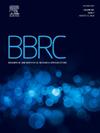Understanding fungal and plant active urea transport systems: Keys from Aspergillus nidulans and beyond
IF 2.5
3区 生物学
Q3 BIOCHEMISTRY & MOLECULAR BIOLOGY
Biochemical and biophysical research communications
Pub Date : 2024-10-13
DOI:10.1016/j.bbrc.2024.150801
引用次数: 0
Abstract
Urea is present in all ecosystems, as a result of the metabolism of different organisms and also of human activity, being the world's most common form of nitrogen fertilizer. Fungi and plants can use urea as a nitrogen source, taking it up from the environment through specialized active transport proteins. These proteins belong to a subfamily of urea/H+ symporters included in the Solute:Sodium Symporter (SSS) family of transporters. In this review we summarize the current knowledge on this group of transporters, based on our previous studies on Aspergillus nidulans UreA. We delve into its transcriptional and post-translational regulation, structure-function relationships, transport mechanism, and certain aspects of its biogenesis. Recent findings suggest that this urea transporter subfamily is more expanded than originally thought, with representatives found in organisms as diverse as Archaea and mollusks, which raises questions on evolutionary aspects. A. nidulans ureA knockout strains provide a valuable platform for expressing urea transporters from diverse sources, facilitating their characterization and functional analysis. In this context, given the close relationship between plant and fungal active urea transporters, this knowledge could serve to develop strategies to improve the efficiency of applied urea as fertilizer.
了解真菌和植物活性尿素转运系统:黑曲霉及其他菌类的关键。
尿素存在于所有生态系统中,是不同生物新陈代谢和人类活动的结果,也是世界上最常见的氮肥形式。真菌和植物可以利用尿素作为氮源,通过专门的活性运输蛋白从环境中吸收尿素。这些蛋白质属于尿素/H+转运体亚家族,包括在溶质:钠转运体(SSS)家族中。在本综述中,我们将根据之前对黑曲霉 UreA 的研究,总结目前有关这组转运体的知识。我们将深入探讨其转录和翻译后调控、结构-功能关系、转运机制及其生物发生的某些方面。最近的研究结果表明,尿素转运亚家族的范围比原来想象的要大,在古细菌和软体动物等多种生物中都发现了其代表,这就提出了进化方面的问题。A. nidulans ureA 基因敲除菌株为表达来自不同来源的尿素转运体提供了一个宝贵的平台,有助于对它们进行特征描述和功能分析。在这种情况下,鉴于植物和真菌活性尿素转运体之间的密切关系,这方面的知识有助于制定战略,提高尿素作为肥料施用的效率。
本文章由计算机程序翻译,如有差异,请以英文原文为准。
求助全文
约1分钟内获得全文
求助全文
来源期刊
CiteScore
6.10
自引率
0.00%
发文量
1400
审稿时长
14 days
期刊介绍:
Biochemical and Biophysical Research Communications is the premier international journal devoted to the very rapid dissemination of timely and significant experimental results in diverse fields of biological research. The development of the "Breakthroughs and Views" section brings the minireview format to the journal, and issues often contain collections of special interest manuscripts. BBRC is published weekly (52 issues/year).Research Areas now include: Biochemistry; biophysics; cell biology; developmental biology; immunology
; molecular biology; neurobiology; plant biology and proteomics

 求助内容:
求助内容: 应助结果提醒方式:
应助结果提醒方式:


